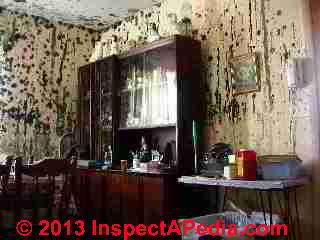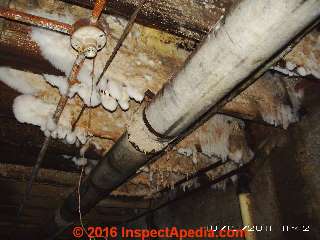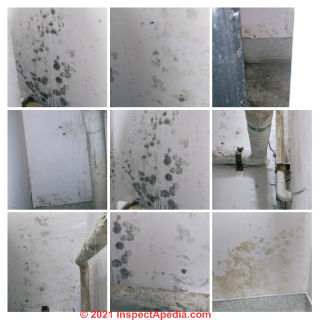 Indoor Mold Contamination Emergency?
Indoor Mold Contamination Emergency?
What to Do & When to Hire a Professional
- POST a QUESTION or COMMENT about how to decide if a mold, odor or other indoor air emergency exists, what to do in an emergency, and how to determine if professional mold inspection & testing are needed
Indoor mold contamination emergency response: this article describes how you may decide that the moldy conditions inside a building are serious enough to treat as an emergency.
InspectAPedia tolerates no conflicts of interest. We have no relationship with advertisers, products, or services discussed at this website.
- Daniel Friedman, Publisher/Editor/Author - See WHO ARE WE?
How to Identify a Building Mold Emergency, Odor Emergency, or Indoor Air Quality Emergency
 Watch out: because individual health risks and site conditions vary widely, no publication can always identify nor solve all problems caused by indoor air contamination.
Watch out: because individual health risks and site conditions vary widely, no publication can always identify nor solve all problems caused by indoor air contamination.
If you believe that an indoor air quality or contamination emergency exists, get out of the building and seek professional help from emergency services such as dialing 911 from a telephone outside of and away from the building.
See IAQ EMERGENCY STEPS for four key actions to take.
But here we provide assistance that will help in identifying an emergency and more assistance that will help determine when you need to hire a professional.
Even a non-emergency situation may require expert professional advice on diagnosis of problem causes and procedures to clean up mold or to remedy other IAQ issues.
At page top and above left we show examples of severe indoor mold contamination. In the extremely mold-contaminated building shown at page top there is no question that if this building had been occupied, it should not be. In an interesting technical experiment the author tested every surface of every different type of building material found inside the structure.
The results were interesting: different mold genera/species had strong preferences for different materials (no surprise). These variations underscore the importance of strategic sample location selection when screening less obviously contaminated buildings for mold.
For example I found completely different mold genera/species growing on the surface of a hollow-core luan interior door than on its edges.
Definition of Mold Emergency: Five Conditions Indicating an Indoor Mold, Odor, or Gas Emergency
 The US EPA identifies five conditions that require immediate or "emergency" response [we have added a few items and some examples]: [6]
The US EPA identifies five conditions that require immediate or "emergency" response [we have added a few items and some examples]: [6]
In the moldy book photo shown at above-left we illustrate a more subtle but serious indoor mold condition. In an in-use basement library area we found books that from a distance just looked "a little moldy".
But the air disturbance caused by merely walking past these books sent visible clouds of green Aspergillus sp. mold spores into the air in extemely high concentrations - a condition we verified in our laboratory
Worse, when the remediators installed rapid dehumidifying equipment, the sudden plummet in indoor humidity so excited the Aspergillus that it sent still much higher levels or spores into building air. Proper dust and mold containment measures were very important at this building to avoid jeapordizing people occupying the in-use upper floors.
- Breathing difficulties that are widespread among building occupants, such as shortness of breath, tightness in the chest, or respiratory irritation. [An individual with breathing difficulties is an individual emergency but may not represent a building emergency.]
Also see MOLD RELATED ILLNESS SYMPTOMS - Carbon monoxide poisoning symptoms: sounding of a CO detector alarm, or [apparently building-related] headaches, dizziness, drowsiness, nausea and combustion odors from heating equipment such as a heating boiler, furnace, or a fireplace, coalstove, or woodstove.
See CARBON MONOXIDE - CO
and HEATING SYSTEM ODORS
and WOOD STOVE OPERATION & SAFETY.
Other gases, concentrated indoors, can also be dangerous but may be harder to detect (CARBON DIOXIDE - CO2).
At GAS EXPOSURE EFFECTS we provide information about a wider range of indoor gas hazards. - Diagnosis of the presence of Legionnaire's disease or tuberculosis in the building or among building occupants.
Also see Legionella BACTERIA & HVAC EQUIPMENT. - Flooded or water-damaged carpeting. [Note that the "emergency" here is the need for quick response to prevent a more costly mold contamination problem in the building.]
Also see CARPET MOLD / ODOR TESTS
and FLOOD DAMAGE ASSESSMENT, SAFETY & CLEANUP.
Watch out: if you see a large area of mold in the building, more than 30 square feet of contiguous mold such as the black mold on drywall in a flooded basement shown in our photos you will need a professional to evaluate and another to correct the problem.] - Obvious life-threatening emergencies such as [a sounding smoke detector, carbon monoxide detector, or other evidence of a carbon monoxide danger or an actual fire in the building], hazardous material spills, [or warnings by officials of an earthquake, tsunami, flooding, or similar disaster that is imminent]
Watch out: a mold-related indoor IAQ emergency condition may exist but may be less obvious, as we explain below.
If you are not sure if a mold emergency exists
Additional information helpful in deciding if an emergency condition exists can be read at
MOLD / ENVIRONMENTAL EXPERT, HIRE ?
...
Reader Comments, Questions & Answers About The Article Above
Below you will find questions and answers previously posted on this page at its page bottom reader comment box.
Reader Q&A - also see RECOMMENDED ARTICLES & FAQs
Question: very moldy drywall repair in a medical clinic - a dialysis center - is this a "Mold Emergency" ?
Hello, I was recently assigned to a "drywall repair" job inside a medical dialysis center. The precise location of this repair was in what I like to call the 'boiler room' where the one & only water heater is housed.
I'm not exactly sure of the required room size per size of water heater but it seemed like this room was entirely to small for starters & one small inadequate vent.
Anyway, when I 1st arrived on site I immediately noticed the large amounts of condensation on the ceiling & puddles on the floor. I completed the wall portion of the drywall repair & left.
By the next day when I got there, it was full on raining inside this tiny room, from above the ceiling & coming thru a large opening that needed the repair. & two more 'bubbles/swells' had developed on the ceiling. Needless to say, the water leak had to be fixed first.
So I punctured a couple holes in the water bubbles to relieve the build-up from above it.
Not sure how long this water leak had been getting worse for but I then noticed what appeared to be black mold growing on at least 2 of the 3 walls.
I'm attaching the photos I took.
This Q&A were posted originally
Moderator reply: immediately protect building occupants and dialysis patients from mold contamination then decide on the proper cleanup & prevention steps
Jenny
I have worked on very similar jobs.
Watch out: the very first concern here is the potential for serious health risks to building occupants, especially patients whose immune systems may be compromised and also to workers who spend a lot of time in the building.
The first action is to warn building management of possibly very serious health risks that justify expert
- Containment of the moldy area to prevent spreading to other areas - that means setting up isolation barriers of plastic and using negative air machines to prevent air movement and dust or particle movement into other building areas
- Cross-Contamination: checking that there is not already contamination of other building areas by mold spores or MVOCs
- Mechanical systems check: make sure (by inspection or if necessary surface testing) that the building ventilation or HVAC systems are not contaminated and are not spreading mold out of the contaminated area
- Determine extent of contamination: follow the water, check building cavitites, inspect for visible mold; do not rely simply on "air tests" or "culture tests" for building mold contamination;
- Remove the mold & fix the cause of its growth.
Note that modly drywall can't be adequately-cleaned; it should be removed and the exposed surfaces cleaned.
See DRYWALL MOLD TESTING
and HIDDEN MOLD in CEILINGS / WALLS finding mold on the wall cavity side of drywall.
Watch out: Do not let people assume that because they didn't notice any complaints that everyone is safe.
While I strongly advise against panic (expensive and not helpful) this situation needs to be treated very seriously. Example: I had a client operating an audiology clinic; they all knew the ceiling was moldy but nobody cared much as nobody had experienced any reaction.
Then a young, apparently-healty client came into the clinic for a hearing test, was shut into the soundproof booth (also mold contaminated) where he went into anaphylactic shock and nearly died. The audiologist didn't know that her client was allergic to mold and perhaps was also asthmatic.
With containment in place cleanup and leak repairs can proceed.
Please keep me posted.
...
Continue reading at MOLD / ENVIRONMENTAL EXPERT, HIRE ? or select a topic from the closely-related articles below, or see the complete ARTICLE INDEX.
Or see these
Mold Emergency Articles
- DIRECTORY of MOLD / ENVIRONMENTAL EXPERTS
- MOLD ACTION GUIDE - WHAT TO DO ABOUT MOLD
- MOLD / ENVIRONMENTAL EXPERT, HIRE ?
- MOLD in BUILDINGS Procedure: what mold is often found where in buildings - simple technical presentation
- UNSAFE ENVIRONMENT, CAN'T LEAVE
Suggested citation for this web page
DEFINITION of MOLD EMERGENCY at InspectApedia.com - online encyclopedia of building & environmental inspection, testing, diagnosis, repair, & problem prevention advice.
Or see this
INDEX to RELATED ARTICLES: ARTICLE INDEX to MOLD CONTAMINATION & REMEDIATION
Or use the SEARCH BOX found below to Ask a Question or Search InspectApedia
Ask a Question or Search InspectApedia
Try the search box just below, or if you prefer, post a question or comment in the Comments box below and we will respond promptly.
Search the InspectApedia website
Note: appearance of your Comment below may be delayed: if your comment contains an image, photograph, web link, or text that looks to the software as if it might be a web link, your posting will appear after it has been approved by a moderator. Apologies for the delay.
Only one image can be added per comment but you can post as many comments, and therefore images, as you like.
You will not receive a notification when a response to your question has been posted.
Please bookmark this page to make it easy for you to check back for our response.
IF above you see "Comment Form is loading comments..." then COMMENT BOX - countable.ca / bawkbox.com IS NOT WORKING.
In any case you are welcome to send an email directly to us at InspectApedia.com at editor@inspectApedia.com
We'll reply to you directly. Please help us help you by noting, in your email, the URL of the InspectApedia page where you wanted to comment.
Citations & References
In addition to any citations in the article above, a full list is available on request.
- [1] Mark Cramer Inspection Services Mark Cramer, Tampa Florida, Mr. Cramer is a past president of ASHI, the American Society of Home Inspectors and is a Florida home inspector and home inspection educator. (727) 595-4211 mark@BestTampaInspector.com Technical review, text clarification, 03/31/2009
- [2] "A Brief Guide to Mold, Moisture, and Your Home", U.S. Environmental Protection Agency US EPA - includes basic advice for building owners, occupants, and mold cleanup operations. See http://www.epa.gov/mold/moldguide.htm
- [3] US EPA - MOLD REMEDIATION in SCHOOLS & COMMERCIAL BUILDINGS - - US EPA
- [4] US EPA - UNA BREVA GUIA a MOHO / HONGO
- [5] US EPA - Mold Remediation in Schools and Commercial Building [ copy on file as /sickhouse/EPA_Mold_Remediation_in_Schools.pdf ] - US EPA
- [6] "Indoor Air Quality Problem Solving Wheel", U.S. EPA (included in [3] above. EPA Telephone for IAQ information & publications: 800-438-4318 S/N 055-000-00390-4
- Allergens: Testing for the level of exposure to animal allergens is discussed at http://www.animalhealthchannel.com/animalallergy/diagnosis.shtml (lab animal exposure study is interesting because it involves a higher exposure level in some cases
- Allergens: WebMD discusses allergy tests for humans at webmd.com/allergies/allergy-tests
- Atlas of Clinical Fungi, 2nd Ed., GS deHoog, J Guarro, J Gene, & MJ Figueras, Centraalbureau voor Schimmelcultures, Universitat Rovira I Virgili, 2000, ISBN 90-70351-43-9
- "IgG Food Allergy Testing by ELISA/EIA, What do they really tell us?" Sheryl B. Miller, MT (ASCP), PhD, Clinical Laboratory Director, Bastyr University Natural Health Clinic - ELISA testing accuracy: Here is an example of Miller's critique of ELISA http://www.betterhealthusa.com/public/282.cfm - Townsend Letter for Doctors and Patients
The critique included in that article raises compelling questions about IgG testing assays, which prompts our interest in actually screening for the presence of high levels of particles that could carry allergens - dog dander or cat dander in the case at hand.
http://www.tldp.com/issue/174/IgG%20Food%20Allergy.html contains similar criticism in another venue but interestingly by the same author, Sheryl Miller. Sheryl Miller, MT (ASCP), PhD, is an Immunologist and Associate Professor of Basic and Medical Sciences at Bastyr University in Bothell, Washington. She is also the Laboratory Director of the Bastyr Natural Health Clinic Laboratory. - Fifth Kingdom, Bryce Kendrick, ISBN13: 9781585100224, - we recommend the CD-ROM version of this book. This 3rd/edition is a compact but comprehensive encyclopedia of all things mycological. Every aspect of the fungi, from aflatoxin to zppspores, with an accessible blend of verve and wit. The 24 chapters are filled with up-to-date information of classification, yeast, lichens, spore dispersal, allergies, ecology, genetics, plant pathology, predatory fungi, biological control, mutualistic symbioses with animals and plants, fungi as food, food spoilage and mycotoxins.
- Fungi, Identifying Filamentous, A Clinical Laboratory Handbook, Guy St-Germain, Richard Summerbell, Star Publishing, 1996, ISBN 0-89863-177-7 (English)
- Our recommended books about building & mechanical systems design, inspection, problem diagnosis, and repair, and about indoor environment and IAQ testing, diagnosis, and cleanup are at the InspectAPedia Bookstore. Also see our Book Reviews - InspectAPedia.
- ENVIRONMENTAL HEALTH & INVESTIGATION BIBLIOGRAPHY - our technical library on indoor air quality inspection, testing, laboratory procedures, forensic microscopy, etc.
- In addition to citations & references found in this article, see the research citations given at the end of the related articles found at our suggested
CONTINUE READING or RECOMMENDED ARTICLES.
- Carson, Dunlop & Associates Ltd., 120 Carlton Street Suite 407, Toronto ON M5A 4K2. Tel: (416) 964-9415 1-800-268-7070 Email: info@carsondunlop.com. Alan Carson is a past president of ASHI, the American Society of Home Inspectors.
Thanks to Alan Carson and Bob Dunlop, for permission for InspectAPedia to use text excerpts from The HOME REFERENCE BOOK - the Encyclopedia of Homes and to use illustrations from The ILLUSTRATED HOME .
Carson Dunlop Associates provides extensive home inspection education and report writing material. In gratitude we provide links to tsome Carson Dunlop Associates products and services.


